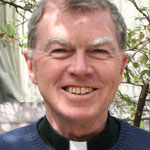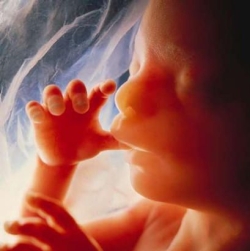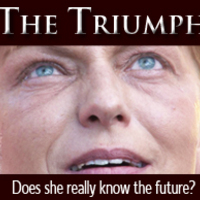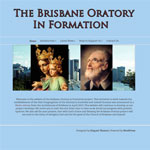Barney Zwartz has a good article in today’s Saturday Age on Fr Kevin Dillon.
As you might imagine, the article contains several clangers. I think we all know that fact-checking isn’t Zwartz’s strong point. Still, this is a good profile of a good man, whom I’ve blogged about before.
The hierarchy has long insisted that the clerical sexual abuse crisis peaked decades ago, and there are rigorous processes now in place which reliably safeguard children. This is no mean feat given the horrifying scale of sexual abuse of children, still ongoing, in the broader community. Credit where it’s due.
But I do think the treatment of survivors of abuse can be improved. Less legalistic, and more pastoral. Fr Dillon can attest to this first-hand, given his extensive contact with many survivors.
Fairfax content is now behind a paywall, but for reasons which escape me, Zwartz’s article doesn’t appear on The Age’s website at all. The column is, however, freely available on another Fairfax website, so I reproduce it here in full.
Kevin Dillon was stopped at traffic lights a couple of years ago when a passing pedestrian peered in the car window at the gold crosses on his collar, recognised him as a priest, and said: “Oh, off to molest a few children, are we?”
13 Jul 2013, THE AGE – by Barney Zwartz
Dillon was cut to the quick. As it happened, he had not long got off the phone from an hour-long conversation with a victim of childhood sexual abuse.
Being accosted that way has probably happened to most priests these days and has made “a world of difference to the way priests feel about their ministry”, Dillon admits.
But in the murky world of suspicion most Catholic priests have to inhabit, alongside the despair they feel at the truculent attitude of the hierarchy towards critics, few priests have so won the respect and admiration of the survivors of abuse as the 68-year-old parish priest at Geelong’s St Mary of the Angels Basilica.
He spends at least a dozen hours a week with victims, gave important evidence to the Victorian inquiry into how the churches handled sexual abuse and has become an unofficial and rather reluctant spokesman for those inside the church unhappy with the present system. He has done all this while running one of Victoria’s biggest and oldest parishes, Geelong, where he tends 4000 families.
“I think I’d be dead if it weren’t for Kevin,” says Catherine Arthur, a former nun who was a victim of clerical abuse as a child, then an adult. “I was being treated so badly by the church. He’s just been enormously helpful, he’s so kind. He found me the unit where I am living and got on eBay and got me all my furniture.”
People don’t know what he does for others, Arthur says. “He gave one victim the jacket off his back and a small wardrobe of clothes to another victim who is the same size.”
Last Christmas Eve, she says, he got home from a meeting at 2am, the phone went and he had to go to the hospital. He got home and it went again – back to the hospital.
“He just gives and gives and gives. It’s really costing him, dealing with the victims. He’s aged. We all think he should be a bishop. But he’s too outspoken, speaking up for the truth and for what could and should be done – he won’t get any medals for that.”
Dillon is indeed generous, so much so that he actually gave away his home 10 years ago. An Anglican woman sought his help to find a big house in Geelong for respite care for people with terminal illnesses. “And I thought, I live in a big house in Geelong. So we found a smaller place for me to live over the road,” he recalls. “Anam Cara House has become a respected part of Geelong’s community care.”
Dillon made a notable mark in the Melbourne church. He was parish priest at Mitcham for 16 years before being posted to Geelong, served for seven years as director of vocations and was Victorian director of the 1986 visit by pope John Paul II.
“That was a bit like organising the grand final and Melbourne Cup within 24 hours,” Dillon says. “We had 100,000 at the MCG on Thursday night and 120,000 at Flemington racecourse on the Friday afternoon.”
Despite being the public face of dissenting Catholics when it comes to treatment of childhood sexual abuse victims – contradicting the hierarchy, who claim the problems have been virtually solved – Dillon considers himself a conservative priest. He has always liked the middle of the road and is a reluctant rebel. “I’ve never had an official challenge. I’ve never sought media coverage of my own views but I made a promise to myself and to the Good Lord that if I was asked, I would say what I thought.”
He criticises policy and processes, not people (such as bishops), and sees his work with victims as a vocation within a vocation. But his human and – above all – patient approach to dealing with victims of sexual abuse by the clergy has put him on a different trajectory to Catholic officialdom. This became explicit when he told the Victorian inquiry in February that the formal church protocols must be scrapped.
“Time is up; the church has had more than a fair chance. The Melbourne Response and Towards Healing have lost all credibility and are beyond repair,” he said, lamenting that the response had been heartless and adversarial and showed “a culture of denial” about the impact on victims.
Dillon first got involved with victims about 20 years ago when a woman being abused at home rang him. “She didn’t know me, she dialled me because I was the next number. It was 3am and I talked to her. She eventually took her own life.”
Then in 1998 he was rung by another woman, “an adult victim of a sleazebag priest who assaulted her in hospital. That call began at 8pm and finished at two in the morning.”
As the abuse crisis unfolded, he looked on aghast, like many Catholics. He crossed his Rubicon after the infamous remark by now Parramatta Bishop Anthony Fisher about the Foster family during the 2008 Australian visit of pope Benedict XVI. Fisher described the Fosters – two of whose daughters were repeatedly raped in primary school and one of whom had killed herself five weeks earlier – as “dwelling crankily on old wounds”.
Dillon recalls: “I got furious and rang Neil Mitchell on 3AW and said, ‘I just cringe’. I identified myself and people started to contact me, particularly through [victims’ advocate] Helen Last.” Now he has spoken to about 50 victims, most of them regularly.
“There’s been lots of cappuccinos at the local coffee shop round the corner,” he says. “So many victims have never contacted anyone and for every victim, perhaps another dozen people have been scarred and feel helpless.
“It’s interesting that they want to talk. Many of them have had nothing to do with priests for years. But Catholic faith becomes part of your DNA, so when there’s a glint of understanding and support they grab it.”
That is what saddens Dillon most about the official response: so many do not find that sense of support. “I have yet to see anyone who has been through the system and is happy with it. People say I’m only talking to the grizzlies, and that may be right, but if there are so many people happy with the system, where are they?” He also asks why the church does not follow up victims and why it has not established support groups.
“If the idea was to save money it’s been a great success, I don’t think. Look at the number of people who have walked away from the church, who no longer volunteer, who change their wills. How do you calculate that?”
Now he spends a dozen hours a week talking to victims, in person or on the phone. “Some ring me late at night, they’ve maybe had a few drinks. All I can do is listen.”
It’s not that they expect a resolution but it’s important to give them time – he might just be keeping someone alive. Add this to a frantic workload – four Masses every weekend, half a dozen baptisms a month, 80 weddings a year and perhaps 300 funerals – and Dillon concedes it takes a toll. He has to go from happy (wedding) to sad (funeral) in moments and he does feel these emotions.
“Where the toll is, it’s not just people in distress – psychologists do that all the time. The most difficult thing is that [abuse] brings into the spotlight that the church I love – that I have been part of all my life – behaves to these very wounded people in ways that are inconsistent with its mission.”
All they want is a sense of their own dignity or worth, he says, so when the church is adversarial “it is taking advantage in a horrendous way. If you buy something from Myer and take it back, Myer is pretty good about that. If the reaction of the staff is argumentative and defensive, you get angry. People come back to the church, which teaches, ‘Love one another as I [Christ] have loved you’, wanting us to reach out in love and support. The first contact should be pastoral, not legal – tell me your story.”
That pastoral emphasis is certainly Dillon’s strength – he likes people. At funerals, for example, he does not stand on ceremony. On a cold winter’s day he is burying a great-grandmother whose husband he buried three months ago. The family is stoic and dignified and Dillon gives them plenty of freedom, including allowing a Geelong Cats flag to flutter by the coffin.
The daughter is a staunch Protestant but she is quite content. “Kevin’s been absolutely wonderful and it’s all about respecting what they would like. It’s not whose theology is right,” she says.
Funerals are time-consuming but Dillon sees them as an essential part of what he does. “It brings us into contact with a lot of people who may not have a lot to do with the church, so it’s important to make this a positive experience for them at a time of great pain.”
Strictly speaking, he shouldn’t allow a football club flag at a Catholic service but what head office doesn’t know won’t hurt it. “Too often with funerals, and even weddings, we see that people are coming into our space and should do what we tell them, but in reality they are inviting us into a critical part of their lives, whether of great sadness or joy.”
Bishops can lose sight of this, he believes. Priests need constant interaction with people on the ground floor, which is easiest in a parish. “If I were pope I’d make sure every bishop was serving in a parish. They’d belong, be grounded. Bishops don’t do the weddings and funerals of the real people.
“Imagine if we had had 12 regional bishops in Melbourne [there are three] and each had a small parish.”
How does he nourish his own faith, give himself the spiritual energy to keep going and giving? “I made a commitment and I’ve maintained it for 51 years since I went to seminary, of daily connection by the Mass. I’ve never been one of those people who can sit in church for hours praying. The value of the Mass, and the sense of God’s presence in the Mass, is very important – it’s my touchstone, because it’s something only a priest can do.
“It’s an expression of identity. I’m lucky that 44 years down the track [from being ordained] I still enjoy what I do.”
Another ritual that keeps him sane is a weekly trip up the Geelong Road to Glen Waverley, where he has a coffee with his siblings – sister Geraldine, the prototype TV chef who had a cooking program on Channel Nine for 20 years, brother John, a semi-retired solicitor, and brother Brendan, the parish priest at Glen Waverley. The children of Victoria’s first ombudsman, they share a sense of the importance of a fair go.
“I try to get up here three times a month – it’s the closest I get to a day off, Sunday afternoons,” he says.
But despite everything, he has never doubted his vocation or the church. “With the church, for all its faults, of which we are all well aware, it may be a case of you don’t know what you’ve got till it’s gone. Church is one of the few places where people come regularly and are encouraged to live a life of service and care for each other.
“A lot of other places, it’s pretty dog eat dog. So even if the people giving the words of wisdom don’t live the way they should, putting forward the Christian gospel can make a difference to them and to society as a whole.”






Fr Dillon was instrumental in me becoming a Catholic when I was 16yo. He was a fine example of a faith-filled person truely livingas a disciple of Jesus, he was an inspiration to me. Fr Dillon baptised and confirmed me and I received my first Holy Eucharist from him. I am still a practising Catholic and Fr Dillon is still an inspiration to me on how to be a follower of Jesus. May God bless Fr Kevin Dillon!
I read part of this article on Saturday, and I finished it today. He’s one of those people that, without restraint, lives life like Christ. He is that person that brings peace when he walks into a house, heals the sick, revives faith, and bears the burdens of many others.
The church, the world, would do well to have so many more of him. I note that his siblings are all involved in some sort of service to society as well. Bless him, his family, and the lives that he touches.
I live in Rowville and Fr. Dillon is my parish priest. We all love him. Father Dillon as many many priests I have known since childhood all bearing some kind of Jesus personality. So far I haven’t met even one bad priest yet. Trust our lord, there are more thousand times of good and lovely priests than the bad one (only very small %). The good things the church done no one mentioned but it will be very big news around the world if something going wrong or bad, especially within the Catholic church.
Refer to Cardinal George Pell’s case: Before I moved to Rowville. I’d lived in Richmond and quite often attended Mass in St Patrick Cathedral during the time Cardinal George Pell was an Archbishop.
One day, after Sunday Mass (full of people), I heard loud noise in front of the church, the drums, the gongs, etc… people screaming, people yelling condemned the Archbishop to Hell! After mass, I found out there was a protest from the Broken Rites and few other groups. Amazingingly! the Archbishop calmly came out in front of the church greeting parishioners as his normal routine after mass. I wonder why those people hate him so much and since then I have been interested in any news involved with George Pell. I slowly realise that Social Media has always painted him as a very bad and ugly person, the police target him and finally put their guns on him.
I attended two processions and a few big congregations during his time as an Archbishop and I could be one of his witness. To me, the prosecution against Cardinal George Pell based on trust and feeling on the compliant more than the evidences. Obviously the crown case doesn’t have solid evidences against him because it based only on one witness, the compliant himself and in the impossible scenarios to make it happened. No wonder why Prosecutor Boyce was struggling to explain his case on Thursday when questioning by the Judges.
I personally believe Cardinal George Pell suffering for the sins of Pedophile Priests but he himself innocent. Even the case was brought up to the High Court. If fairly judge on evidences, it is again the prosecutors will find struggling to explain their accusations. The answer is that it is simply impossible to be happened.
In 2011, a similar case of a former Philadelphia altar boy dubbed “Billy Doe” which wrongly sent 4 people to jail, three priests and one teacher (please google “Billy Doe” to read the full story). It proves that false accusation can happen.
Let’s pray for justice to be done for every one and let’s pray for the sinners as our Lord teach us.
Thanking for reading my point of view. English is my second language so please forgive my broken English and I hope you understand my views. In God, Trust Our Holly Church. We are one body : Love, Forgive and not divided.